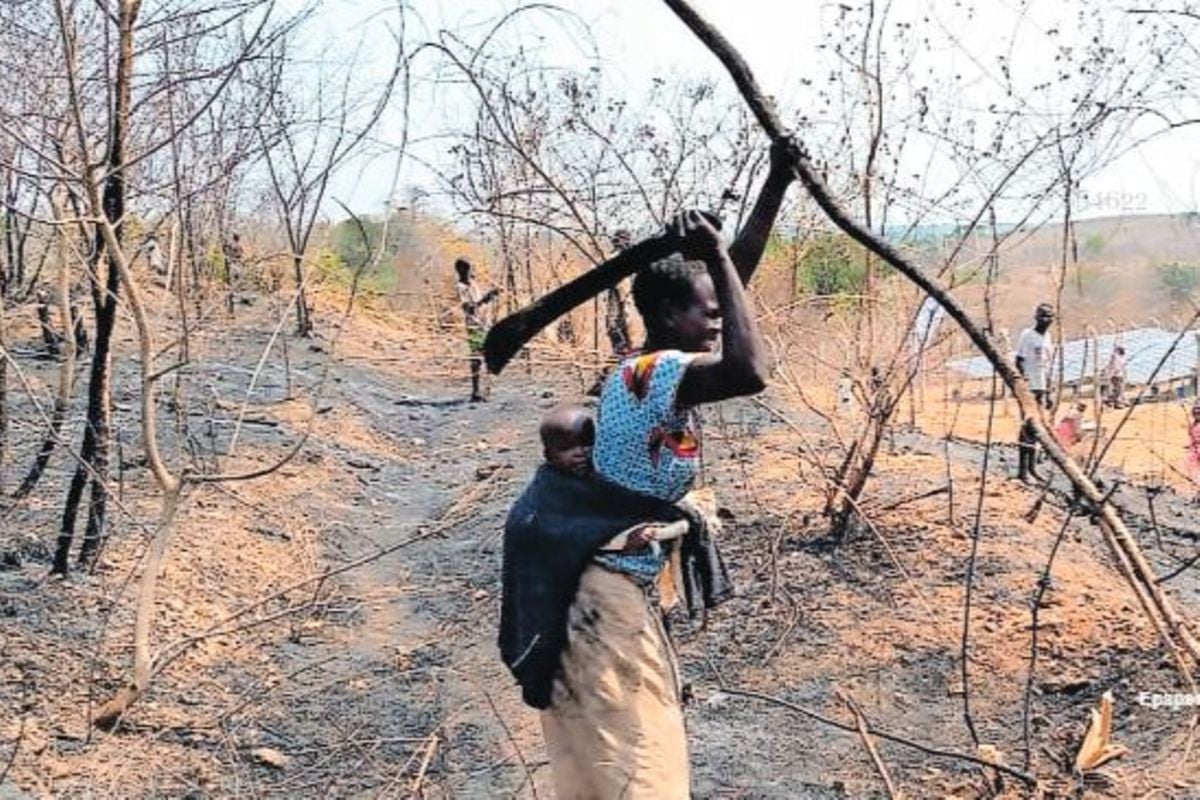Since time immemorial, during dry seasons, farmers in Lamwo District have burnt grass in their gardens to stimulate the growth of fresh green grass for their livestock and to enhance soil fertility.
Smallholder farmers believe dry grass is not nutritious to their animals, and in a desperate search for alternative grasslands, set fire to the abundant dry grass left behind. The wind-driven fires move quickly, destroying trees and human settlements along the way.
Mr Willy Okullo, an associate professor in the Department of Physics at Kyambogo University, says the historical practice was perfected when tribes in northern Uganda were still cattle keepers.
“During the hunting season, groups of hunters fire on bushes to provide passage of animals into areas where snares had been placed. Unfortunately, today, farmers are still using the same method to enhance soil fertility,” he says.
In the dry months of December, January and February, fields across the entire administrative unit along the Uganda-South Sudan border go up in flames due to reckless bush burning.
“The farmers are doing the opposite of what they want to achieve. They think that when rains come, the dust and ashes from the burnt grass will turn into manure. They do not know that vegetation is a carbon sink,” Prof Okullo adds.
Bushfires cause air pollution, kill insects and destroy animal habitats. They also kill plant species, destroy watershed points, and contribute to global warming, resulting in climate change. In turn, climate change is exacerbating the hot, dry conditions that help the fires catch and spread quickly.
Compared to countries like the United States of America (USA), Australia, and Kenya, Ugandan bushfires are small-scale. A few years ago, there was skepticism about the role bushfire smoke played in reducing the concentration of the ozone layer in the stratosphere.
However, last year, a study published in Nature, a multidisciplinary science journal showed that 900,000 tonnes of bushfire smoke and particles emitted during Australia’s 2019-2020 Black Summer thinned out the ozone layer by one percent. The researchers say the damage will take a decade to restore.
The ozone layer blocks ultraviolet-B rays from the sun and without it, plants would die while humans and mammals would develop skin cancers.
Mr Denis Okello, a farmer in Kal Parish, Patongo Sub-county in Agago District, says many of his peers are not aware of the dangers of bush burning.

Residents flee after a razing wildfire gutted houses in Koboko Town in 2023. PHOTO/FELIX WAROM OKELLO
“It can cause extensive damage to crops, forests, and even human settlements, posing a threat to both household income and to the environment. Much as bush burning may offer short-term advantages such as nutrient cycling and land clearing, its long-term disadvantages outweigh these benefits,” he says.
The situation is the same in the West Nile Sub-region, where the community burns government and privately owned forest reserves at will. Some of the forest reserves include Acwera Forest along the Nebbi-Pakwach road, Laura Central Forest in Arua District, Mt Kei Forest in Yumbe, and Metu Forest in Moyo District.
Ms Cynthia Adiru, a resident of Terego District, says some of the bushfires are started by children, for fun.
“Children move with a matchbox in their pockets and as they go to the riverside at Enyau to bathe or when they go hunting for birds, they burn any bush in sight. The fires spread to people’s farmlands and woodlots,” she says.
In 2023, more than 200 acres of sorghum, cowpeas, cassava, sugarcane, and bananas were destroyed by wildfires in Moyo and Arua, according to data from the two districts.
In 2017, an uncontrolled fire burned about 24 grass-thatched houses, five goats and six cows in Moyo District. In Koboko District, 20 houses near Koboko market were destroyed due to wildfires that spread to the area.
“Human beings like the by-products of trees and trees like the by-products or respiration of human beings. So, plants, grass, and bushes act as a sink for greenhouse gases. That is why climate change bodies and agencies are advocating for, and sometimes offering financial support for tree planting,” Prof Okullo says.

A farmer grazes cattle on a ground exposed after bush burning in Labongo Akwang Sub-county, Pader District, on February 14. PHOTO/BILL OKETCH
The Prohibition of the Burning of Grass Act, of 1974, prohibits the intentional burning of grass by any person in all areas of Uganda. The Act stipulates the only people with the power to grant permission to burn grass: the sub-county chief, a forest officer, and a wildlife officer.
Mr Sodrick Ogwang, Lira District’s youth chairperson, says even though the district local government has ordinances and by-laws on bush burning, eliminating the practice is difficult.
“There are no incentives and alternatives to motivate people to comply with the law. There is a need for a mindset change because besides burning bushes to facilitate hunting and the new planting season, some people just look at a piece of land with dry grass and set fire on it for no particular reason,” he says.
Prof Okullo advises farmers that there are alternatives to bush burning, which also ensure soil fertility.
“When you cultivate land, the vegetation which is down in the soil should be left to rot and become manure to make the place fertile. You can also adopt rotational farming. A mindset change means that if one wants to eat meat, he does not need to go to the bush or Game Park to hunt animals. We encourage them to start rearing edible animals from home,” he says.
Prof Okullo adds that bush burning will eventually affect the country’s tourism because wild animals die in the fire, yet tourism is a major foreign exchange earner.
The adverse effects of bush burning in northern Uganda can already be felt in the rising temperatures. A prior warning by the Food and Agriculture Organisation (FAO) of the United Nations indicated that Uganda could lose Shs260 billion to rising temperatures by 2050 due to the effects of climate change.
The UN agency notes that there has been a 0.2 degree Celsius increase in temperatures every decade in Uganda since 1960 and this may increase to 5.3 degree Celsius by 2080.
“Last year, we witnessed the highest temperatures in the sub-region, up to 42 degrees Celsius. Our neighbour, South Sudan, went up to 45 degrees Celsius – something which has never happened before,” Mr Richard Ociti, the Lamwo District environment officer, says.
Continual bush burning means that the ozone layer will be eventually degraded by smoke.

















